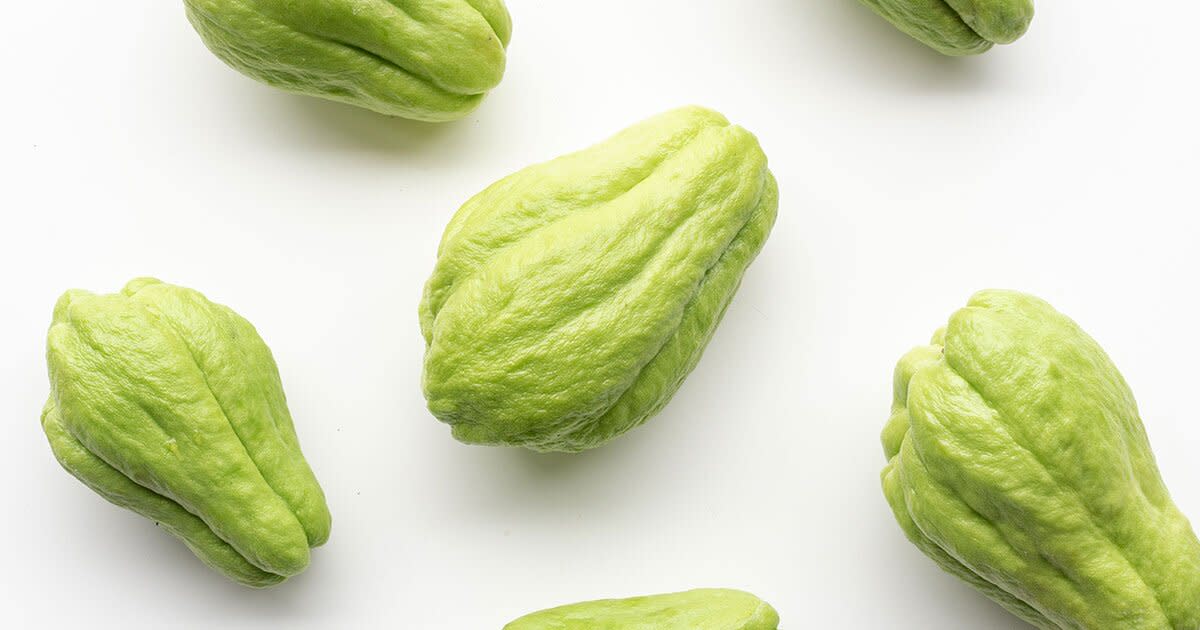What Is Chayote Squash, Exactly?

Photo: Natalie Board / Shutterstock
Sure, you know about pumpkins (and their lattes) and have likely heard about butternut and acorn squash, too. But what about chayote squash? Similar to a pear in size and shape, this bright green gourd is a type of summer squash that boasts a long, vibrant history *and* is stocked with essential nutrients such as fiber, magnesium, and calcium. Here are chayote's benefits, along with how to buy, cook, and eat chayote.
What Is Chayote?
Chayote (aka vegetable pear or mirliton) is a type of summer squash, says Wesley McWhorter, M.S., R.D., chef and dietitian at UTHealth School of Public Health. It's technically considered a fruit — much like a tomato — but it probably isn't something you want to bite into like an apple. Mild in taste and crunchy in texture, this lumpy green gourd grows on a long climbing vine in warm climates across the globe. While it only made its way to the U.S. in the late nineteenth century, chayote’s been cultivated since pre-Columbian times, according to the Center for New Crops and Plant Products at Purdue University.
In fact, findings suggest that a variety of chayote squash — Sechium edule — was widely distributed in “Mesoamerica” (the geographical and cultural area extending from Mexico down through Central America, including Guatemala, Belize, Honduras, and El Salvador). From there, it’s believed that the pear-shaped squash spread south towards (and throughout) South America, further solidifying itself as an integral part of cuisines and even medical treatments, according to the Center for New Crops and Plant Products at Purdue University. While chayote leaves aren’t still used today to dissolve kidney stones, the fruit as a whole is still loaded with potential benefits. And on that note…
Chayote's Benefits and Nutrition
Similar to other fruits, chayote is high in antioxidants and vitamins — specifically vitamin B, vitamin C, potassium, and amino acids. It has a super impressive nutrition profile, too: One chayote (~203 grams) has just 39 calories, .3 grams of fat, and 9 grams carbohydrates, according to the U.S. Department of Agriculture (USDA). While it's not necessarily the most protein-packed produce on the market (1.7 grams in one chayote), the summer squash is packed with other positive nutrients, such as filling fiber, mood-boosting magnesium, and bone-strengthening calcium.
That said, a vast amount of the nutrients are in the peel, so be sure to keep it on while cooking and eating. Overall, chayote works well as a replacement for starchy vegetables for anyone looking to cut carbs or who is following a low-carb diet such as keto or Atkins.
How to Buy Chayote
Chayote is available in grocery stores. However, if your produce section leaves something to be desired, you may have better luck finding it at more of a specialty store such as Whole Foods or at your local farmers' market. Because warm climates offer a longer growing season for chayote squash, it's more likely that the fruit will be available year-long in areas with warmer weather.
To choose a ripe chayote, look for one that's firm to the touch, between light and dark green in color, and without any brown soft spots (varying colors are fine as long as the fruit is firm).
How to Cook and Eat Chayote
There's no one answer as to how to cook chayote. You can eat all parts of the squash (and probably should, especially since lots of the nutrients are in the peel), which makes it versatile for cooking and eating. Each method will bring out different flavors and textures. For example, grilling caramelizes the chayote due to its sugar content.
Need a little inspo? Here's how to enjoy chayote squash at home:
Eat it raw: Chef Saul Montiel from Cantina Rooftop in New York City uses it raw and julienned to add crunch to a salad; finished with lime juice, spicy Mexican seasoning (Tajin), and olive oil and, violá, you've got yourself an easy (and fibrous!) chayote creation.
Use it in soup: The mild flavor means that you can season the squash to suit any palette. Chayote can handle bold spices such as chipotle, harissa, and curry. "My favorite way to use chayote is in a traditional soup that my mom served at her restaurant in Mexico: mole de olla," says Chef Montiel. It's made of chayote squash, zucchini, green beans, corn, potato, chambarete and aguja (steak) meat, submerged into a chili broth, and seasoned with garlic, onion, and epazote (a Mexican herb). "The chayote balances the spiciness and adds a sweet taste to the short rib soup," says Chef Montiel.
Roast it: One of the easiest ways to begin experimenting with chayote (or any new vegetable, TBH) is by roasting it. McWhorter recommends this simple roasted chayote recipe: 2 tablespoons oil of your choice + ground black pepper + 1 pound chopped chayote. Bake at 375°F for 15 to 20 minutes. Then add salt-but only after the chayote is cooked. Science lesson: Salt draws moisture out of plant cell walls through osmosis. "If you draw moisture out while a water-rich vegetable (or fruit) cooks, it leads to a dehydrated and burnt final product with poor texture, especially with summer squash and eggplant varieties," says McWhorter. If you wait until after, you still get the salty taste — without the risk of ruining the chayote in the process. Bottom line: This tip is going to change your roasting game forever. (Related: 9 Kinda Brilliant Roasted Vegetable Combinations)
Editor's note: A previous version of this article implied that chayote squash was not a well-known vegetable. This was not our intention, and we recognize how such a sentiment could be interpreted as culturally insensitive. We have therefore updated this article to reflect chayote’s rich and long history, along with its health benefits.

